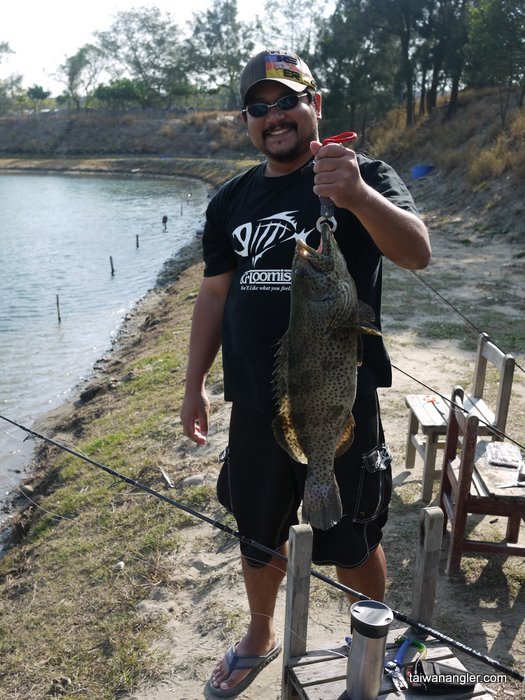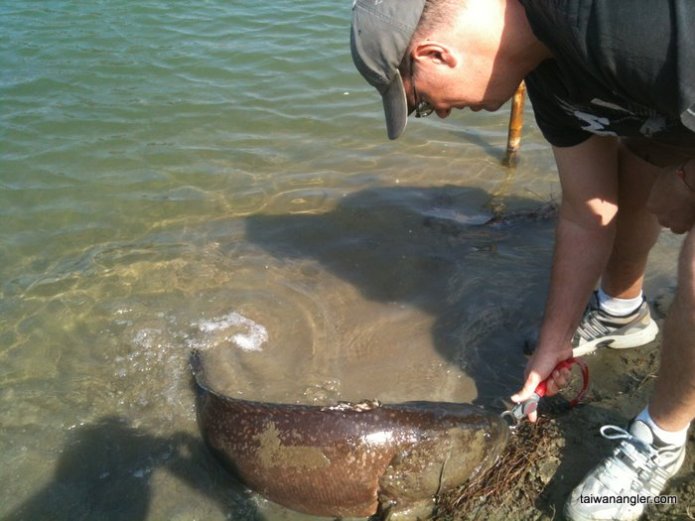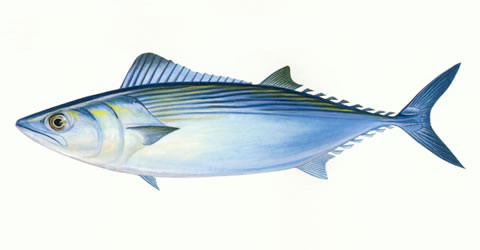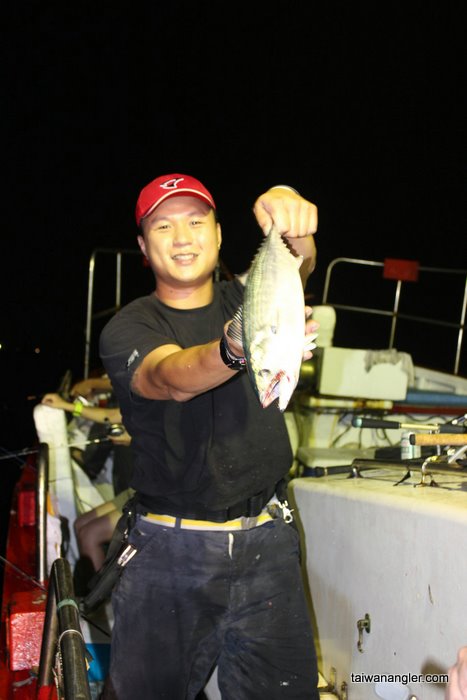Jhunan Grouper Action
 Monday, October 31, 2011 at 1:23PM
Monday, October 31, 2011 at 1:23PM I finally tried something this weekend that I have been planning to do for quite some time—visit one of the many saltwater fishing ponds along the eastern coast of Taiwan. An expat angler I met through this site who lives in Hsinchu county has been telling me about a pond he and his friends frequent in nearby Jhunan. This weekend I finally had time to take him up on the offer come down and give it a try.
 Our first fish was a "small" one landed by Austin.Up just before dawn on Sunday morning, I was soon heading down the highway for my 7 a.m. rendezvous with Austin, a Kiwi who, being unwed and unburdened with children (OK, a “burden” I happily accept), seems to find time for angling that I could only dream of. He is particularly keen on the saltwater variety and often makes it down to Green Island and other offshore spots for his favorite activity—jigging for amberjacks and tuna.
Our first fish was a "small" one landed by Austin.Up just before dawn on Sunday morning, I was soon heading down the highway for my 7 a.m. rendezvous with Austin, a Kiwi who, being unwed and unburdened with children (OK, a “burden” I happily accept), seems to find time for angling that I could only dream of. He is particularly keen on the saltwater variety and often makes it down to Green Island and other offshore spots for his favorite activity—jigging for amberjacks and tuna.
Once Austin’s gear was stored in the car, we headed to the fishing pond with a quick detour along the way for bait. The pond itself is tucked down a country road along an estuary not far from the Number 3 Highway. It would be difficult to locate without a guide or GPS. The Google satellite map shows it as a single pond, but it has since been divided into two.
One pond allows you to keep your catch, and anglers pay NT$1,200 to fish for the day. This “keeper pond” is stocked with sea bass, black sea bream (porgy), milk fish and several other species. The second pond is stocked with a few different species of large grouper, some tipping the scale at over 20 kg. You don’t get to keep these brutes, but for NT$200 you can spend the day testing your tackle and arm muscles wrestling them up to shore. And that’s exactly what we came to do.
After unpacking our gear, we staked out a corner of the pond that Austin said was particularly productive and got down to business. I was clear that the keeper pond was more popular with locals than the grouper pond as we were the only anglers on the catch-and-release side when we arrived. A few more anglers would show up as the day progressed, but never as many as the keeper side of things.
As we set about rigging up, I was beginning to feel a bit like a hunter that brought a sling shot on an elephant hunt. The heaviest rod I have is a 7’ medium-action bass rod. Austin had assured me that this would be fine since he had landed one of his biggest groupers on a light freshwater spinning combo. On this day, however, he would be favoring a thick saltwater popping rod. It felt a bit strange rigging my comparatively flimsy rod with 70 lb. leader and 8/0 hooks, but I was willing to play along.
Onto these massive hooks we threaded bloody six-inch fillets of mackerel. Austin said that there was no need to cast out to the middle of the pond since the groupers tend cruise along the edges when they are feeding. So, we tossed our baits a few meters out, opened the bails on our spinning reels and waited. It was a pleasant way to spend the morning. The sky was mostly clear and pines lining the levee provided shade and blocked some of the gusting wind. This bruiser was too heavy to lift with the lip grip.
This bruiser was too heavy to lift with the lip grip.
It wasn’t too long before something began stripping line off of Austin’s reel. He grabbed the rod and after a brief tussle, beached a “small” 7 or 8 kg. grouper. We popped the hook out, took a few photos and sent our first fish on its way. After this point, the strikes came to a sudden halt and the action cooled off for the next few hours. We were getting worried as midday approached and there had been no more strikes, since the hours around noon tend to be the slowest in the pond. Just around 11:30, several fish could be seen foraging around the edge of the pond. It wasn’t long before the line stripping off Austin’s reel. Graciously he waved me over to do the honors.
I gave the fish a few seconds to take the bait all the way it its mouth before snapping the bail closed and setting the hook. That did little to stop the grouper’s progress across the pond as it continued to take line. Drag singing and rod bent over, it may not have been a “wild” fish on the end of the line, but it was definitely fun worth the price of admission. Finally able to turn the fish around and gain some ground after a little back and forth, I was able to drag up onto the sandy shore a bruiser that Austin estimated at a little over 12 kg. Try as we might to lift him with my puny lip grip for a photo, he was back on the ground with a shake of his tail. We took a few shots on the ground and sent him on his way.
All in all it was a great half day of fishing. Austin said the action really picks up just before dusk. The grouper pond shuts down after sunset, but the keeper pond stays open into the night. I’ll definitely be heading back (with heavier tackle) to give it another go.
 Chris Jackson |
Chris Jackson |  Post a Comment |
Post a Comment |  1 Reference | | tagged
1 Reference | | tagged  grouper,
grouper,  pay ponds,
pay ponds,  saltwater fishing,
saltwater fishing,  saltwater pond in
saltwater pond in  Fishing Report
Fishing Report 











